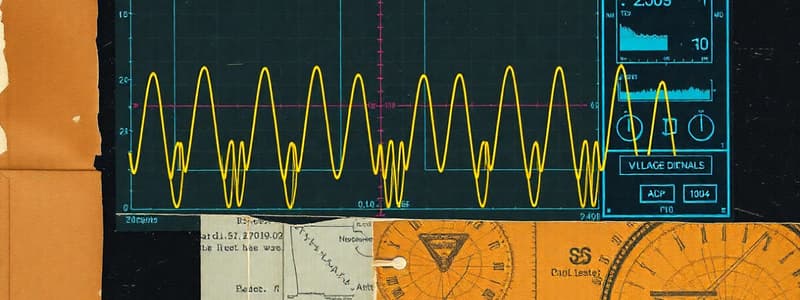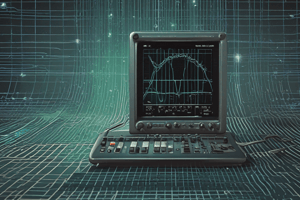Podcast
Questions and Answers
What is the primary purpose of the vertical gain control on an oscilloscope?
What is the primary purpose of the vertical gain control on an oscilloscope?
- To scale the signal in the horizontal axis.
- To alter the time scale of the signal.
- To adjust the trigger levels for synchronization.
- To scale the signal in the vertical axis. (correct)
When maximizing the signal within the graph using the coarse control, what is achieved?
When maximizing the signal within the graph using the coarse control, what is achieved?
- Increased trigger sensitivity.
- Improved resolution of the time axis.
- A clearer representation of the signal amplitude. (correct)
- Reduced visibility of small signal details.
What does pressing the vertical gain knob do?
What does pressing the vertical gain knob do?
- Modifies the horizontal shift of the signal display.
- Alters the trigger level for the signal capture.
- Changes the scaling from Coarse to Fine adjustment. (correct)
- Switches between different measurement modes.
Which axis displays the peak-to-peak amplitude on an oscilloscope?
Which axis displays the peak-to-peak amplitude on an oscilloscope?
What is the primary purpose of an oscilloscope?
What is the primary purpose of an oscilloscope?
What does the horizontal gain control affect?
What does the horizontal gain control affect?
In an oscilloscope's 2D graph, which direction represents signal amplitude?
In an oscilloscope's 2D graph, which direction represents signal amplitude?
Which of the following properties can be analyzed using an oscilloscope?
Which of the following properties can be analyzed using an oscilloscope?
When using an oscilloscope, how does one measure time intervals?
When using an oscilloscope, how does one measure time intervals?
Which component is essential for capturing a signal on an oscilloscope?
Which component is essential for capturing a signal on an oscilloscope?
What is the purpose of adjusting the horizontal gain on an oscilloscope?
What is the purpose of adjusting the horizontal gain on an oscilloscope?
When setting the trigger on an oscilloscope, what does the trigger type determine?
When setting the trigger on an oscilloscope, what does the trigger type determine?
What effect does using Fine adjustments on the oscilloscope have on signal analysis?
What effect does using Fine adjustments on the oscilloscope have on signal analysis?
If an LED lights up once per minute, where should the trigger be set on an oscilloscope?
If an LED lights up once per minute, where should the trigger be set on an oscilloscope?
What is the recommended horizontal gain setting for a signal with a period of 200 ms on a 10-interval graph?
What is the recommended horizontal gain setting for a signal with a period of 200 ms on a 10-interval graph?
What is the purpose of the vertical shift function on the Y-axis of an oscilloscope?
What is the purpose of the vertical shift function on the Y-axis of an oscilloscope?
Which adjustment should be used for compressing or stretching the signal on the horizontal axis?
Which adjustment should be used for compressing or stretching the signal on the horizontal axis?
When setting trigger levels, which of the following statements is correct?
When setting trigger levels, which of the following statements is correct?
What action should be taken after selecting Channel 1 or 2 on the oscilloscope?
What action should be taken after selecting Channel 1 or 2 on the oscilloscope?
How can one maximize viewing the signal amplitude on an oscilloscope?
How can one maximize viewing the signal amplitude on an oscilloscope?
What does pressing the knob in the vertical or horizontal section of the oscilloscope do?
What does pressing the knob in the vertical or horizontal section of the oscilloscope do?
For setting the Timebase divisions on an oscilloscope, what is the correct action?
For setting the Timebase divisions on an oscilloscope, what is the correct action?
What is a typical use of the Auto Scale button on an oscilloscope?
What is a typical use of the Auto Scale button on an oscilloscope?
Flashcards
Oscilloscope
Oscilloscope
An electronic instrument that displays electrical signals as a graph over time.
Waveform
Waveform
The graph that shows how a signal's voltage changes over time.
Peak-to-Peak Amplitude
Peak-to-Peak Amplitude
The difference between the maximum positive and maximum negative voltage values of a signal.
Period
Period
Signup and view all the flashcards
Vertical Gain
Vertical Gain
Signup and view all the flashcards
Vertical Shift
Vertical Shift
Signup and view all the flashcards
Horizontal Gain
Horizontal Gain
Signup and view all the flashcards
Horizontal Shift
Horizontal Shift
Signup and view all the flashcards
Trigger
Trigger
Signup and view all the flashcards
Run/Stop
Run/Stop
Signup and view all the flashcards
Cursors
Cursors
Signup and view all the flashcards
Signal Amplitude
Signal Amplitude
Signup and view all the flashcards
2D Graph
2D Graph
Signup and view all the flashcards
Signal Period
Signal Period
Signup and view all the flashcards
Periodic Signal
Periodic Signal
Signup and view all the flashcards
Signal Trace
Signal Trace
Signup and view all the flashcards
Input
Input
Signup and view all the flashcards
Coarse Adjustment
Coarse Adjustment
Signup and view all the flashcards
Fine Adjustment
Fine Adjustment
Signup and view all the flashcards
Auto Scale
Auto Scale
Signup and view all the flashcards
Study Notes
Oscilloscopes - Analog or Digital
- An oscilloscope is an electronic test instrument that displays electrical signals on a graph.
- The graph, often called a "waveform", shows how signal voltage varies over time.
- Oscilloscopes are used to analyze waveform properties like amplitude, frequency, rise times, time intervals, and distortion.
Voltage Signals on 2D Graphs
- Many electronic signals are periodic, meaning they repeat consistently, like sound waves, heartbeats, and generator outputs.
- These signals can be converted to voltage and displayed over time on a 2D graph, typically with 10 columns and 8 rows of intervals.
2D Graph Properties
- 2D graphs allow observation of voltage signals over time (represented by a V/t graph).
- The Y-axis represents vertical direction, showing signal amplitude (strength).
- The X-axis represents horizontal direction, showing signal time (or frequency).
Reading Properties of a Signal
- By observing the waveform on the oscilloscope, you can measure properties such as:
- Peak-to-Peak Amplitude: The difference between the maximum positive and maximum negative voltage values.
- Period: The time it takes for the waveform to complete one cycle.
Oscilloscope Control Layout
- Oscilloscopes have a variety of controls, including:
- Run/Stop: Starts or stops the waveform acquisition
- Trigger: Determines the starting point of the waveform display
- Horizontal Gain: Controls the time scale (t/div) on the X-axis
- Horizontal Shift: Moves the waveform left or right on the X-axis
- Vertical Gain: Controls the voltage scale (V/div) on the Y-axis
- Vertical Shift: Moves the waveform up or down on the Y-axis
- Cursors: Used for precise measurement of voltage and time intervals
- Measure: Provides numerical measurements of various waveform properties (like amplitude, frequency, etc.)
Vertical Gain
- Vertical gain scales the waveform vertically, stretching or compressing it along the Y-axis.
- Rotating the vertical gain knob adjusts the V/div display.
- Pressing the knob toggles between Coarse and Fine adjustments, allowing for precise control.
Vertical Shift
- Vertical shift moves the waveform up or down along the Y-axis.
- Rotating the vertical shift knob adjusts the signal's position.
- Pressing the knob aligns the signal with the "zero" position.
### Horizontal Gain
- Horizontal gain scales the waveform horizontally, stretching or compressing it along the X-axis.
- Rotating the horizontal gain knob adjusts the t/div display.
- Pressing the knob toggles between Coarse and Fine adjustments, allowing for precise control.
Horizontal Shift
- Horizontal shift moves the waveform left or right along the X-axis.
- Rotating the horizontal shift knob adjusts the signal's position.
- Pressing the knob aligns the signal with the "zero" position.
Trigger
- The trigger determines the starting point of the waveform display.
- Rotating the trigger knob adjusts the voltage level at which the waveform starts.
- Pressing the knob aligns the signal with the "zero" position.
- You can choose different trigger types like rising-edge or falling-edge to capture specific points in a waveform.
### Oscilloscope - Setting Up a Signal
- To observe a signal on the oscilloscope:
- Turn on the power. Allow time for the oscilloscope to boot up.
- Apply the signal: Connect the signal to the Oscilloscope's input, choosing Channel 1 or 2.
- Find the signal trace: Click "Default Setup" on the oscilloscope. Rotate knobs for trigger, horizontal gain, and vertical gain to reset them to zero. Alternatively, enable "Auto Scale" for automated adjustment.
- Set the Voltage divisions: Rotate vertical gain to maximize the viewing of the signal amplitude. Use 5-8 intervals on the Y-axis for optimal viewing. For example, if the waveform has a 4Vp-p amplitude, set Vertical Gain to 2V/div.
- Set the Timebase divisions: Rotate horizontal gain to display 1 or 2 full cycles of the signal. Use 5-8 intervals on the X-axis for optimal viewing. For example, if the signal has a 200ms period, set the horizontal gain to 20ms/div or 50ms/div.
- Adjust the trigger: Choose a suitable trigger type and voltage level. For example, to capture an event happening once a minute, trigger at 1V rising-edge.
- Fine-tune the image: Use the Fine adjustments on vertical and horizontal gains to zoom in for more detail. Remember, this increases the difficulty in measuring amplitude and period.
Studying That Suits You
Use AI to generate personalized quizzes and flashcards to suit your learning preferences.




